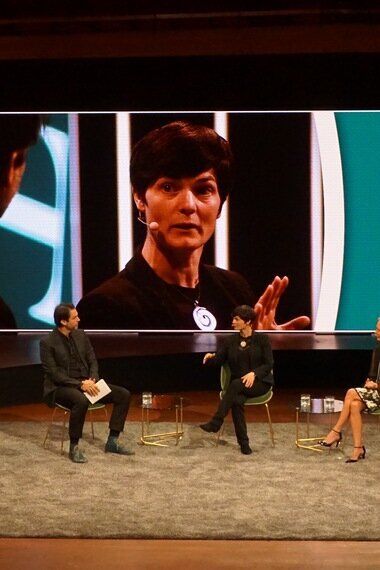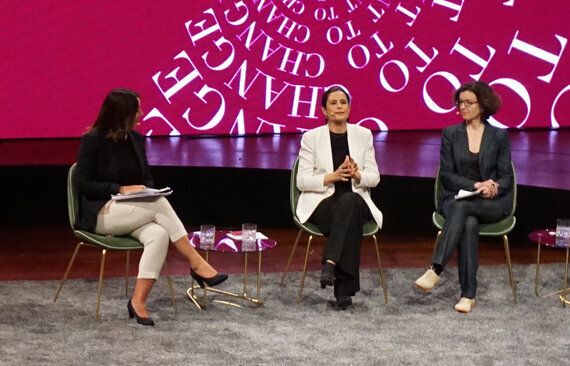
'Is that Dhaka?', I wondered as a film taking us on a tour through a rabbit warren of a damp, dark textile workshop played on the backdrop of the Copenhagen Fashion Summit stage. It's actually Gujarat in India - Machines by Rahul Jain opened the summit and reminded us of why we we're here.
Sustainability is at the top of the Copenhagen Fashion Summit agenda, in an effort to discuss the damage done by our industry - fashion - the second most polluting in the world after oil and gas. The garment industry has depleted the world's natural resources to an extent that our planet can no longer support. Underpinning the Copenhagen Fashion Summit was a report called the Pulse of the Fashion Industry, created by Boston Consulting Group in conjunction with the Global Fashion Agenda. The findings, summarised by Javier Seara of Boston Consulting Group and Caroline Chalmer of Global Fashion Agenda, were presented as both a challenge and opportunity. The main challenge being to change the entire supply chain from a linear 'take, make, dispose of in landfill (in 80% of cases*)' model, to a circular 'collect (used textiles or garments), disassemble (and chemically/mechanically separate the fibres), make new textiles from the recycled fibres, make new garments, repeat' model.


The Copenhagen Fashion Summit Agenda and the Pulse of the Fashion Industry report
Current demands on the planet are predicted to lead to serious ethical crises if they continue - such as a situation where there will not be enough water for drinking and cotton growth in some countries - leading to a choice between one or the other. Population growth at its current rate will lead to consumption of clothing at 62% higher levels than today by 2030, when 8.5 billion people will inhabit earth. The impact of this on natural resources will be catastrophic if alternatives to current resource depleting practices are not invented, designed and implemented. I say invented, because the outcome of these claims, from the Pulse of the Fashion Industry report, is a need for collaboration and innovation. These two words were, by my judgement, the most used of the summit. Repeatedly, collaboration between the largest fashion brands to combine resources and exert their influence, and innovation in the supply chain by manufacturers, were hailed as key requirements to make leaps forward, away from linear manufacturing models and towards circular ones. Shedding light on this, Jason Kibbey of the Sustainable Apparel Coalition stated that "leaders of innovation are factory owners - they are (innovating) in the supply chain". He added "(this innovation) doesn't come from Europe, or Silicon Valley - it comes from Asia". Considering the demographic in the audience, mostly western and white, I realise that a critical voice of this discussion is missing. Jason later explained to me in an interview that he was heading to Bangalore, India, next week for a summit on sustainable benchmarks for the garment industry, to work with manufacturers in Asia on how to put sustainability initiatives and certifications in place.
It is important to note that the Pulse of the Fashion Industry report's deductions were based on the responses from sustainability officers in 90 fashion companies, providing a rather skewed set of data, and collated and reported according to the Higg Index. The limitations of the report were acknowledged by the Boston Consulting Group, and given that the report's data was subjective and unverified by any third party, the report was delivered as a starting point for a discussion on sustainability, rather than a final solution.
Hard-hitting and sobering facts were delivered by Dame Ellen MacArthur of the Ellen MacArthur Foundation (EMF) during a panel discussion entitled 'For a World Beyond Next Season', from a report the EMF compiled with McKinsey in 2010. The report's express purpose was to analyse the merits of incremental improvements in a linear economy - which are finite - versus a circular economy model. Dame Ellen explained that we would need 1.7 planets to keep up with our current demands on the planet, therefore making a circular model imperative, where we would work in a restorative way instead of a wasteful way.

Dame Ellen MacArthur speaks at the Copenhagen Fashion Summit
Wading into the ethical and environmental argument was Livia Firth of Eco-Age, citing her co-panellist, independent barrister Jessica Simor QC's report Fashion Focus: The Fundamental Right to a Living Wage as holding the answers to current questions and misconceptions about barriers to fair pay to those working in the garment industry. Describing it as the 'elephant in the room' at this summit, and the last summit one year ago, she warned brands that they were in big trouble, given the findings of Simor's report. Simor pulled no punches in explaining articulately and succinctly that minutiae in legal documents were clouding the path to finding solutions to paying the living wage to all in the supply chain. She stated very simply that workers in 14 countries were being paid 50% less (at best) than the living wage. All companies engaged in this business are in breach of UN law, she stated. "See, I told you you were all in trouble" added Livia Firth. Refreshingly clear, Simor added a powerful reminder that the slave trade was not abolished "through transparency and consumer choice", but by law. "Current laws protect consumers here in Europe, not makers in the far East", she said. Providing full clarity, she also stated that the right to a minimum wage is the right to a living wage - highlighting how semantics has got in the way of people being allowed to live in accordance with their human rights in a safe and dignified manner. The report is downloadable from thecircle.ngo and I look forward to reading it in full once my coverage of the Copenhagen Fashion Summit event is wrapped. The second stage of the report is being crowdfunded now and to support this initiative you can donate here and follow The Circle's work on Instagram and Twitter.

Livia Firth (centre) and Jessica Simor QC (right) speak at the Copenhagen Fashion Summit
Stand by for part two of my summit overview.
Follow Techstyler on Twitter and Instagram
*source: Ellen MacArthur Foundation
Originally posted on Techstyler.fashion
All photos by Techstyler
